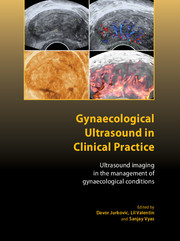 Gynaecological Ultrasound in Clinical Practice
Gynaecological Ultrasound in Clinical Practice Published online by Cambridge University Press: 05 February 2014
Introduction
In the past, ovarian cysts coincidental with pregnancy were considered to be rare. However, the reported prevalence of ovarian cysts detected antenatally has significantly increased in recent years. A likely cause of this trend is the increasing use of ultrasound examination in pregnancy. In addition to the traditional 20-week anomaly scan, many women are now also being offered ultrasound scans in the first trimester of pregnancy. The indications for this include pregnancy dating, suspected early pregnancy failure and first-trimester screening for chromosomal abnormalities. A routine examination of the adnexa is a standard part of ultrasound examination in obstetrics and gynaecology. This practice has introduced an informal ‘screening process’ whereby a large number of asymptomatic pregnant patients are screened for adnexal pathology.
The presence of an ovarian cyst is traditionally considered to be an indication for operative intervention for fear of ovarian cancer and acute complications of ovarian cysts, such as torsion, rupture and obstruction of labour. However, these risks are difficult to quantify and it is possible that many asymptomatic women with ovarian cysts are being overtreated. This is of particular concern in pregnancy, when the risks of operative complications are increased.
Epidemiology
The prevalence of ovarian cysts in pregnancy depends on the sensitivity of the screening test, the diagnostic criteria defining an ovarian cyst and the timing of the examination in pregnancy. Two studies described the prevalence of ovarian cysts in pregnancy before the routine use of ultrasound, when the diagnosis was based on clinical examination of women with symptoms suggestive of an adnexal mass.
To save this book to your Kindle, first ensure [email protected] is added to your Approved Personal Document E-mail List under your Personal Document Settings on the Manage Your Content and Devices page of your Amazon account. Then enter the ‘name’ part of your Kindle email address below. Find out more about saving to your Kindle.
Note you can select to save to either the @free.kindle.com or @kindle.com variations. ‘@free.kindle.com’ emails are free but can only be saved to your device when it is connected to wi-fi. ‘@kindle.com’ emails can be delivered even when you are not connected to wi-fi, but note that service fees apply.
Find out more about the Kindle Personal Document Service.
To save content items to your account, please confirm that you agree to abide by our usage policies. If this is the first time you use this feature, you will be asked to authorise Cambridge Core to connect with your account. Find out more about saving content to Dropbox.
To save content items to your account, please confirm that you agree to abide by our usage policies. If this is the first time you use this feature, you will be asked to authorise Cambridge Core to connect with your account. Find out more about saving content to Google Drive.